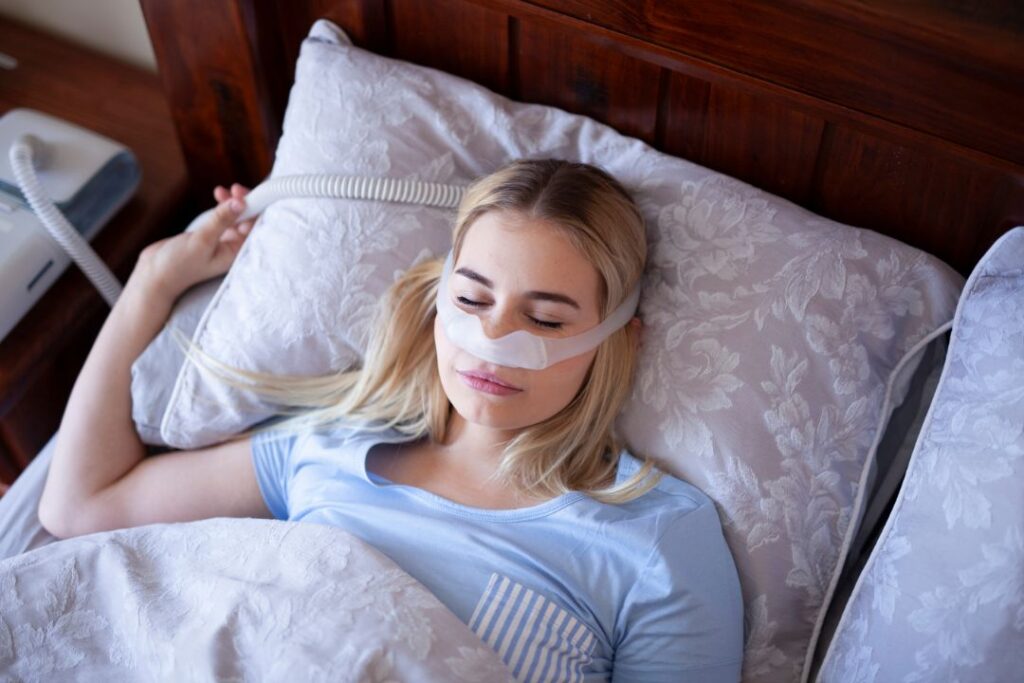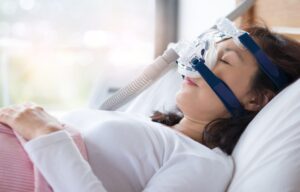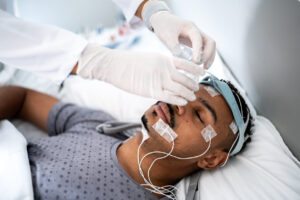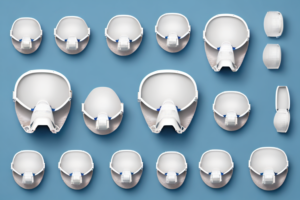The Role of CPAP Masks in Effective Sleep Apnea Treatment

Sleep apnea is a common sleep disorder that affects millions of people worldwide. It is characterized by pauses in breathing or shallow breaths during sleep. These pauses can last for a few seconds to a few minutes and can occur multiple times throughout the night. This interruption in breathing can lead to disrupted sleep, decreased oxygen levels in the blood, and various other health problems.
Understanding Sleep Apnea
Before delving into the importance of CPAP masks in sleep apnea treatment, it is essential to have a clear understanding of what sleep apnea is and its potential effects on one’s health.
Sleep apnea is a sleep disorder that occurs when the muscles in the throat fail to keep the airway open during sleep. This results in repeated disruptions in breathing, which can lead to fragmented sleep and oxygen deprivation.
During sleep, the muscles in the throat relax, causing the airway to narrow or close altogether. This obstruction prevents air from flowing smoothly into the lungs, resulting in brief pauses in breathing. These pauses, known as apneas, can last from a few seconds to a minute and can occur multiple times throughout the night.
While sleep apnea is more common in overweight individuals and those over the age of 40, it can affect people of all ages and body types. Factors such as family history, smoking, alcohol consumption, and certain medical conditions, such as nasal congestion and obesity, can increase the risk of developing sleep apnea.
Symptoms and Risks of Sleep Apnea
Common symptoms of sleep apnea include loud snoring, daytime sleepiness, morning headaches, irritability, and difficulty concentrating. However, it is important to note that not everyone who snores has sleep apnea, and not everyone with sleep apnea snores.
One of the most significant risks associated with untreated sleep apnea is the impact it can have on cardiovascular health. The repeated disruptions in breathing can lead to high blood pressure, as the body is deprived of oxygen during these episodes. Over time, this can strain the heart and increase the risk of developing heart disease, heart attack, and stroke.
Furthermore, sleep apnea can also contribute to the development of other chronic conditions, such as type 2 diabetes. The disrupted sleep patterns and oxygen deprivation can affect the body’s ability to regulate blood sugar levels, increasing the risk of insulin resistance and diabetes.
Additionally, sleep apnea can have a detrimental effect on mental health and overall well-being. The fragmented sleep caused by the constant interruptions in breathing can result in daytime sleepiness, fatigue, and difficulty concentrating. These symptoms can significantly impact a person’s quality of life, affecting their performance at work or school and increasing the risk of accidents and injuries.
It is important to seek medical attention if you suspect you may have sleep apnea. A healthcare professional can conduct a sleep study to diagnose the condition and recommend appropriate treatment options. Also read more about The Side Effects of CPAP Masks and the Solutions by visiting https://villagehealthfoundation.org/the-side-effects-of-cpap-masks-and-the-solutions/

Introduction to CPAP Masks
A CPAP (continuous positive airway pressure) mask is a key component of sleep apnea treatment. It helps keep the airway open by delivering a constant flow of pressurized air into the lungs. This continuous flow of air prevents the collapse of the throat muscles and ensures regular breathing throughout the night.
Sleep apnea is a common sleep disorder characterized by pauses in breathing or shallow breaths during sleep. These pauses can last for a few seconds to a few minutes and can occur multiple times throughout the night. It often results in fragmented sleep and daytime fatigue. CPAP therapy is one of the most effective treatments for sleep apnea, and the CPAP mask plays a crucial role in delivering the necessary pressurized air to keep the airway open.
What is a CPAP Mask?
A CPAP mask is a device designed to be worn over the nose or mouth (or both) during sleep. It is connected to a CPAP machine, which delivers pressurized air through a tube to the mask. The mask acts as a conduit, ensuring that the air reaches the airway and keeps it open, allowing for uninterrupted breathing.
CPAP masks come in various shapes and sizes to accommodate different individuals’ needs. They are typically made of soft, hypoallergenic materials to provide comfort and prevent skin irritation. Many masks also feature adjustable straps or headgear to ensure a secure and personalized fit.
In addition to delivering pressurized air, some CPAP masks also incorporate additional features to enhance comfort and convenience. For example, some masks have built-in exhalation ports that allow for the easy release of exhaled air, reducing the feeling of resistance during exhalation. Other masks may have integrated humidification systems to add moisture to the delivered air, preventing dryness and irritation in the airways.
Different Types of CPAP Masks
There are several types of CPAP masks available, including nasal masks, nasal pillow masks, and full-face masks. Nasal masks cover the nose, while nasal pillow masks have small inserts that rest against the nostrils. Full-face masks cover both the nose and mouth. The choice of CPAP mask depends on individual preference, facial structure, and breathing patterns.
Nasal masks are a popular choice for individuals who breathe primarily through their nose. They provide a secure seal over the nose, ensuring that the pressurized air is delivered effectively. Nasal pillow masks, on the other hand, are ideal for individuals who prefer a more minimalistic design. They offer a seal around the nostrils, allowing for a clear field of vision and less facial contact.
Full-face masks are suitable for individuals who breathe through both their nose and mouth or those who experience nasal congestion. These masks cover a larger area, providing a seal over both the nose and mouth. They are also beneficial for individuals who tend to breathe through their mouth during sleep or those who require higher levels of air pressure.
When selecting a CPAP mask, it is essential to consider factors such as comfort, fit, and ease of maintenance. Trying different mask styles and sizes, consulting with a healthcare professional, and considering personal preferences can help find the most suitable CPAP mask for an individual’s needs.
How CPAP Masks Help Treat Sleep Apnea
CPAP masks play a crucial role in sleep apnea treatment and can significantly improve the quality of life for individuals suffering from this condition.
Sleep apnea is a common sleep disorder characterized by pauses in breathing or shallow breaths during sleep. These pauses can last for a few seconds to a few minutes and can occur multiple times throughout the night. This disruption in breathing can lead to poor sleep quality and a variety of health problems.
The Science Behind CPAP Therapy
CPAP therapy works by providing a continuous, gentle flow of air pressure that acts as a splint to keep the airway open. This prevents the collapse of the throat muscles and reduces breathing disruptions during sleep.
When a person with sleep apnea wears a CPAP mask, the air pressure generated by the machine keeps the airway open, allowing for uninterrupted breathing. The mask is designed to fit securely over the nose and/or mouth, ensuring that the air pressure is delivered effectively.
Benefits of Using CPAP Masks
Using CPAP masks can lead to a myriad of benefits for those with sleep apnea. These include improved sleep quality, reduced daytime sleepiness, increased energy levels, improved mood and cognitive function, and a decreased risk of associated health problems.
Improved Sleep Quality:
One of the primary benefits of using CPAP masks is the improvement in sleep quality. By keeping the airway open and preventing breathing disruptions, individuals can experience a more restful and uninterrupted sleep. This can result in waking up feeling refreshed and rejuvenated.
Reduced Daytime Sleepiness:
Sleep apnea often leads to excessive daytime sleepiness due to the fragmented sleep during the night. By effectively treating sleep apnea with CPAP therapy, individuals can experience a significant reduction in daytime sleepiness. This can improve productivity, concentration, and overall quality of life.
Increased Energy Levels:
When sleep apnea is left untreated, the constant interruptions in breathing can leave individuals feeling exhausted and drained. By using CPAP masks and ensuring a continuous flow of air, individuals can experience increased energy levels throughout the day. This can lead to a more active and fulfilling lifestyle.
Improved Mood and Cognitive Function:
Sleep apnea has been linked to mood disorders such as depression and anxiety, as well as cognitive impairments including memory problems and difficulty concentrating. By effectively treating sleep apnea with CPAP therapy, individuals may experience an improvement in their mood and cognitive function. This can result in a better overall mental well-being and an enhanced ability to perform daily tasks.
Decreased Risk of Associated Health Problems:
Untreated sleep apnea can increase the risk of developing various health problems, including high blood pressure, heart disease, stroke, and diabetes. By using CPAP masks and effectively managing sleep apnea, individuals can reduce the risk of these associated health problems and improve their long-term health outcomes.
In conclusion, CPAP masks are an essential component of sleep apnea treatment. By providing a continuous flow of air pressure, these masks help keep the airway open, preventing breathing disruptions during sleep. The benefits of using CPAP masks include improved sleep quality, reduced daytime sleepiness, increased energy levels, improved mood and cognitive function, and a decreased risk of associated health problems. If you or someone you know is suffering from sleep apnea, it is important to consult with a healthcare professional to determine the most appropriate treatment options, including the use of CPAP therapy.
Choosing the Right CPAP Mask
Choosing the right CPAP mask is essential for effective and comfortable sleep apnea treatment.
Factors to Consider
When selecting a CPAP mask, factors such as individual comfort, facial structure, sleeping position, air pressure requirements, and mask fit should be taken into consideration. It is crucial to consult with a healthcare professional or sleep specialist to determine the most suitable option for your needs.
Popular CPAP Mask Options
There are numerous CPAP mask options available, each with its own unique features and designs. Some popular choices include the ResMed AirFit series, Philips Respironics DreamWear, and Fisher & Paykel Simplus.
Living with a CPAP Mask
Adjusting to and maintaining a CPAP mask is an integral part of successful sleep apnea treatment.
Adjusting to Your CPAP Mask
Initially, wearing a CPAP mask may feel unfamiliar and uncomfortable. It is essential to give yourself time to adjust and practice using the mask during daytime naps to become more familiar with its feel and fit. Proper mask fitting, strap adjustment, and finding the right sleeping position can also increase comfort levels.
Cleaning and Maintaining Your CPAP Mask
To ensure the longevity and effectiveness of a CPAP mask, regular cleaning and maintenance are crucial. Cleaning instructions may vary depending on the mask type, but generally, masks should be washed daily with warm water and mild soap, while the mask components should be replaced as recommended by the manufacturer.
In conclusion, CPAP masks play a vital role in the effective treatment of sleep apnea. Understanding the importance of sleep apnea treatment, the function of CPAP masks, and the process of selecting and maintaining the right mask can significantly improve the overall sleep quality and well-being of individuals with sleep apnea.



